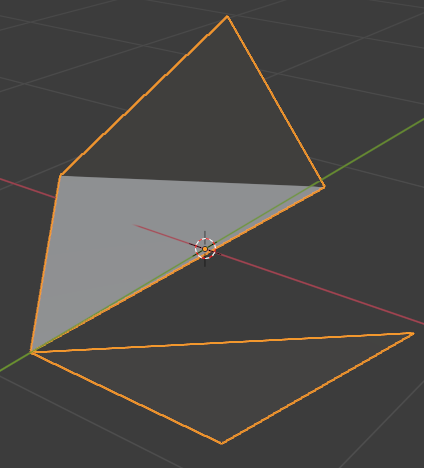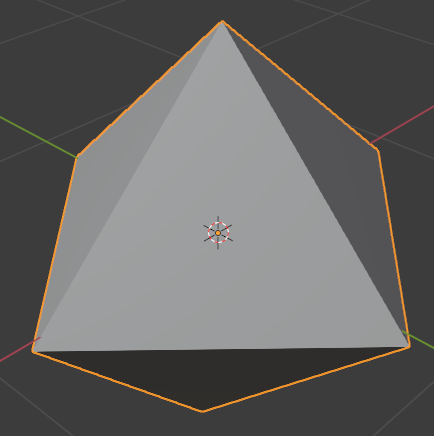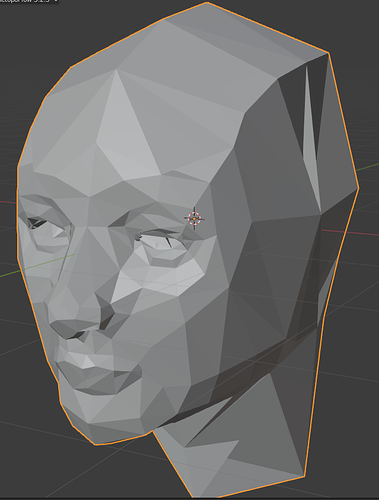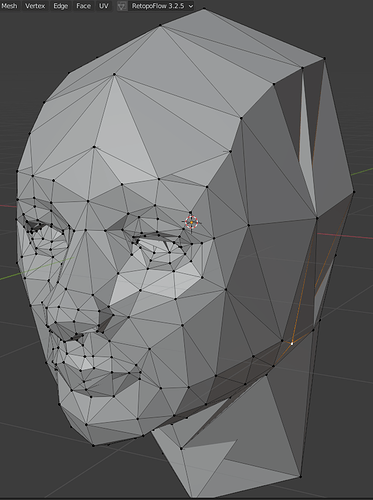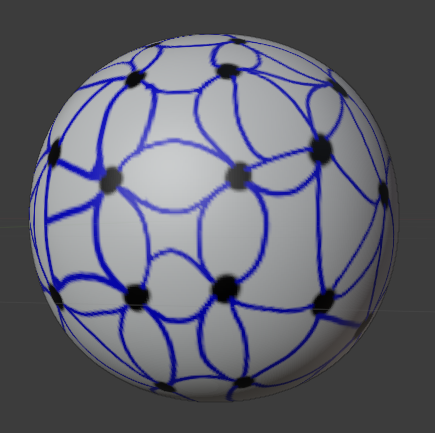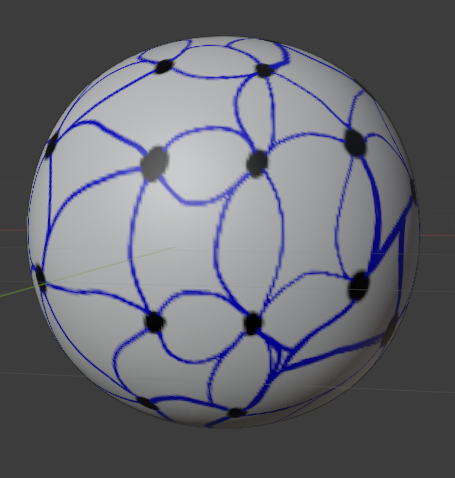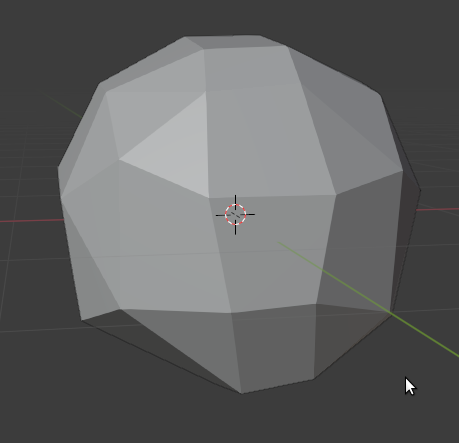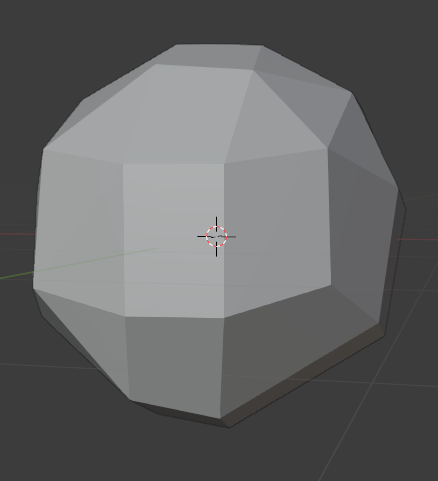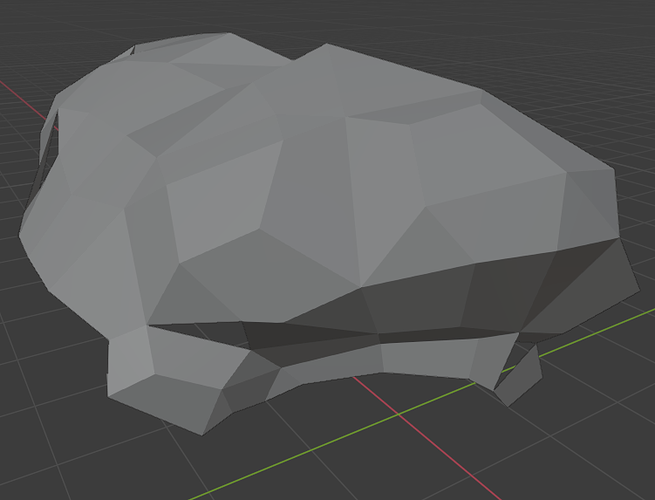I am trying to release the plugin. Hopefully it can be tested and fixed. Or rewritten if needed.
bl_info = {
"name": "Dot Retopo",
"blender": (2, 80, 0),
"category": "Object",
}
import math
import bpy
import bmesh
class ObjectDotRetopo(bpy.types.Operator):
"""Dot Retopo from vertex colors""" # Use this as a tooltip for menu items and buttons.
bl_idname = "dotretopo.dot_retopo" # Unique identifier for buttons and menu items to reference.
bl_label = "Dot Retopo (use vertex colors for new mesh)" # Display name in the interface.
# bl_options = {'REGISTER', 'UNDO'} # Enable undo for the operator.
def getdis(self,cord1,cord2):
# thecord=(cord1-cord2).length #speed increase
thecord= (cord2.x-cord1.x)**2 + (cord2.y-cord1.y)**2 + (cord2.z-cord1.z)**2
thecord=math.pow(thecord,0.5)
return thecord
def sharevertex(self,poly,poly2):
v1=poly.vertices[0]
v2=poly.vertices[1]
v3=poly.vertices[2]
t1=poly2.vertices[0]
t2=poly2.vertices[1]
t3=poly2.vertices[2]
if(v1==t1):
return True
if(v1==t2):
return True
if(v1==t3):
return True
if(v2==t1):
return True
if(v2==t2):
return True
if(v2==t3):
return True
if(v3==t1):
return True
if(v3==t2):
return True
if(v3==t3):
return True
return False
#does poly2 share an edge with any poly in thelist
def sharevertexList(self,themesh,thelist,thelistsize,poly2):
scan=0
while(scan<thelistsize):
poly=themesh.data.polygons[thelist[scan]]
v1=poly.vertices[0]
v2=poly.vertices[1]
v3=poly.vertices[2]
t1=poly2.vertices[0]
t2=poly2.vertices[1]
t3=poly2.vertices[2]
if(v1==t1):
return True
if(v1==t2):
return True
if(v1==t3):
return True
if(v2==t1):
return True
if(v2==t2):
return True
if(v2==t3):
return True
if(v3==t1):
return True
if(v3==t2):
return True
if(v3==t3):
return True
scan+=1
return False
#test if color green color with error correction at half value
def testGreenHalf(self,col1):
ret = True
if(col1[0]>0.4):
ret=False
if(col1[1]<0.5):
ret=False
if(col1[2]>0.4):
ret=False
return ret
#test if color blue color with error correction at half value
def testBlueHalf(self,col1):
ret = True
if(col1[0]>0.3):
ret=False
if(col1[1]>0.3):
ret=False
if(col1[2]<0.5):
ret=False
return ret
#test if color Red color with error correction
def testRedHalf(self,col1):
ret = True
if(col1[0]<0.5):
ret=False
if(col1[1]>0.4):
ret=False
if(col1[2]>0.4):
ret=False
return ret
#test if color Red color with error correction
def testRed(self,col1):
ret = True
if(col1[0]<0.9):
ret=False
if(col1[1]>0.1):
ret=False
if(col1[2]>0.1):
ret=False
return ret
#test if color green color with error correction
def testGreen(self,col1):
ret = True
if(col1[0]>0.1):
ret=False
if(col1[1]<0.9):
ret=False
if(col1[2]>0.1):
ret=False
return ret
#test if color blue color with error correction
def testBlue(self,col1):
ret = True
if(col1[0]>0.1):
ret=False
if(col1[1]>0.1):
ret=False
if(col1[2]<0.9):
ret=False
return ret
def testBlue2(self,col1):
ret = True
if(col1[0]>0.0):
ret=False
if(col1[1]>0.0):
ret=False
if(col1[2]<0.9):
ret=False
return ret
#test if color black color with error correction at 0.4
def testBlackHalf(self,col1):
ret = True
if(col1[0]>0.4):
ret=False
if(col1[1]>0.4):
ret=False
if(col1[2]>0.4):
ret=False
return ret
#test if color black color with error correction
def testBlack(self,col1):
ret = True
if(col1[0]>0.1):
ret=False
if(col1[1]>0.1):
ret=False
if(col1[2]>0.1):
ret=False
return ret
def testPolyColor2(self,mesh,poly):
ret=False
color_layer=mesh.data.vertex_colors.active
scanli=0
while(scanli<len(poly.loop_indices)):
v1=poly.loop_indices[scanli]
# if(self.testBlack(color_layer.data[v1].color)==True):
if(self.testBlackHalf(color_layer.data[v1].color)==True):
ret=True
break
scanli+=1
return ret
def testPolyColorGreen(self,mesh,poly):
ret=False
color_layer=mesh.data.vertex_colors.active
scanli=0
while(scanli<len(poly.loop_indices)):
v1=poly.loop_indices[scanli]
if(self.testGreenHalf(color_layer.data[v1].color)==True):
# if(self.testGreen(color_layer.data[v1].color)==True):
ret=True
break
scanli+=1
return ret
def testPolyColorBlue(self,mesh,poly):
ret=False
color_layer=mesh.data.vertex_colors.active
scanli=0
while(scanli<len(poly.loop_indices)):
v1=poly.loop_indices[scanli]
# if(self.testBlueHalf(color_layer.data[v1].color)==True):
if(self.testBlue(color_layer.data[v1].color)==True):
ret=True
break
scanli+=1
return ret
def testPolyColorRed(self,mesh,poly):
ret=False
color_layer=mesh.data.vertex_colors.active
scanli=0
while(scanli<len(poly.loop_indices)):
v1=poly.loop_indices[scanli]
if(self.testRedHalf(color_layer.data[v1].color)==True):
# if(self.testRed(color_layer.data[v1].color)==True):
ret=True
break
scanli+=1
return ret
#closes polygon vertices at center.
def closePoly(self,themesh,polysrc):
mesh=themesh.data
v1=polysrc.vertices[0]
v2=polysrc.vertices[1]
v3=polysrc.vertices[2]
newop=mesh.vertices[v1].co
newop=(newop+mesh.vertices[v2].co)/2
newop=(newop+mesh.vertices[v3].co)/2
mesh.vertices[v1].co=newop
mesh.vertices[v2].co=newop
mesh.vertices[v3].co=newop
return
#randomily places polygon vertices ontop of polygon vertices.
def movePolyTo(self,themesh,polysrc,polyfr):
mesh=themesh.data
v1=polysrc.vertices[0]
v2=polysrc.vertices[1]
v3=polysrc.vertices[2]
t1=polyfr.vertices[0]
t2=polyfr.vertices[1]
t3=polyfr.vertices[2]
cord=(mesh.vertices[t1].co+mesh.vertices[v1].co)/2
mesh.vertices[t1].co=cord
mesh.vertices[v1].co=cord
cord=(mesh.vertices[t2].co+mesh.vertices[v2].co)/2
mesh.vertices[t2].co=cord
mesh.vertices[v2].co=cord
cord=(mesh.vertices[t3].co+mesh.vertices[v3].co)/2
mesh.vertices[t3].co=cord
mesh.vertices[v3].co=cord
return
#outdated unused function
#move entire group of vertices into one central location
def closeGroup(self,thelist,themesh):
if(thelist[0]==-1):
return
#find mid point of first face
poly=themesh.data.polygons[thelist[0]]
newod=(themesh.data.vertices[poly.vertices[0]].co + themesh.data.vertices[poly.vertices[1]].co + themesh.data.vertices[poly.vertices[2]].co )/3
scan=1
while(thelist[scan]!= -1):
poly=themesh.data.polygons[thelist[scan]]
#first find mid point of face
newod2=(themesh.data.vertices[poly.vertices[0]].co+themesh.data.vertices[poly.vertices[1]].co+themesh.data.vertices[poly.vertices[2]].co)/3
#find mid point of faces
newod=(newod+newod2)/2
scan+=1
scan=0
while(thelist[scan]!= -1):
poly=themesh.data.polygons[thelist[scan]]
themesh.data.vertices[poly.vertices[0]].co=newod
themesh.data.vertices[poly.vertices[1]].co=newod
themesh.data.vertices[poly.vertices[2]].co=newod
scan+=1
# themesh.data.update()
return
def testBlackNearEdge(self,themesh,poly,edgeTable):
ret= -1
scan=0
while(scan<3):
vert=themesh.data.vertices[poly.vertices[scan]]
scanedge=0
while(scanedge<9 and edgeTable[(vert.index*10)+scanedge]>=0):
poly=themesh.data.polygons[edgeTable[(vert.index*10)+scanedge]]
if(self.testPolyColor2(themesh,poly)==True):
return poly.index
scanedge+=1
scan+=1
return ret
def testBlackNearEdge2(self,themesh,poly,bllist,edgeTable):
ret= -1
scan=0
while(scan<3):
vert=themesh.data.vertices[poly.vertices[scan]]
scanedge=0
while(scanedge<9 and edgeTable[(vert.index*10)+scanedge]>=0):
poly=themesh.data.polygons[edgeTable[(vert.index*10)+scanedge]]
if(self.testPolyColor2(themesh,poly)==True):
# if(bllist[poly.index]==True):
return poly.index
scanedge+=1
scan+=1
return ret
#finds the three closest black dots to red dots location given by thecord.
#builds a list of them and returns it.
def findRedDot(self,themesh,thecord,numbgroups,bco):
#thecord is .co cordinate
#bgroup is list of polygon group numbers. flags of polygons of themesh.
#bco is precalcauted black group cordinates.
if(numbgroups<3):
return [0,1,2]
ret= [0,1,2]
scanlist=0
scancords=0
testcord1=themesh.data.polygons[0].center*0#create vertex data object
while(scancords<3):
testcord1[0]=bco[(scancords*3)]
testcord1[1]=bco[(scancords*3)+1]
testcord1[2]=bco[(scancords*3)+2]
dis1=self.getdis(testcord1,thecord)
scanlist=0
while(scanlist<numbgroups):
if(scanlist!=ret[scancords]):
testcord1[0]=bco[(scanlist*3)]
testcord1[1]=bco[(scanlist*3)+1]
testcord1[2]=bco[(scanlist*3)+2]
dis2=self.getdis(testcord1,thecord)
if(dis2<=dis1):
if(ret[0]!=scanlist and ret[1]!=scanlist and ret[2]!=scanlist):
ret[scancords]=scanlist
dis1=dis2
scanlist+=1
scancords+=1
return ret
def findGreenDot2(self,themesh,thecord,bgroup,numbgroups,bco):
#thecord is .co cordinate
#bgroup is list of polygon group numbers.
if(numbgroups<4):
return [0,1,2,0]
ret= [0,1,2,3]
scanlist=0
scancords=0
testcord1=themesh.data.polygons[0].center*0#create vertex data object
while(scancords<4):
testcord1[0]=bco[(scancords*3)]
testcord1[1]=bco[(scancords*3)+1]
testcord1[2]=bco[(scancords*3)+2]
dis1=self.getdis(testcord1,thecord)
scanlist=0
while(scanlist<numbgroups):
if(scanlist!=ret[scancords]):
testcord1[0]=bco[(scanlist*3)]
testcord1[1]=bco[(scanlist*3)+1]
testcord1[2]=bco[(scanlist*3)+2]
dis2=self.getdis(testcord1,thecord)
if(dis2<=dis1):
if(ret[0]!=scanlist and ret[1]!=scanlist and ret[2]!=scanlist and ret[3]!=scanlist):
ret[scancords]=scanlist
dis1=dis2
scanlist+=1
scancords+=1
return ret
#locate the corners of the dot lines
def findBlueDot(self,thelist,blist,bllist,themesh,edgeTable):
if(thelist[0]==-1):
return
cords=0#number already indexed.
retlist=[-1,-1,-1,-1]#list of black dot groups numbers
scan=0
while(thelist[scan] != -1 and cords<4):#//find the two,three,four black dots
poly=themesh.data.polygons[thelist[scan]]
vert1=themesh.data.vertices[poly.vertices[0]]
vert2=themesh.data.vertices[poly.vertices[1]]
vert3=themesh.data.vertices[poly.vertices[2]]
#test all faces of all three vertices
scanvert=0
while(edgeTable[(vert1.index*10)+scanvert] != -1 and scanvert<19 and cords<4):
testpoly=themesh.data.polygons[edgeTable[(vert1.index*10)+scanvert]]
if(self.testPolyColor2(themesh,testpoly)):
# if(bllist[testpoly.index]==True):
if(self.testList(retlist,4,blist[testpoly.index])==False):
retlist[cords]=blist[testpoly.index]
cords+=1
else:
ptest=self.testBlackNearEdge(themesh,testpoly,edgeTable)
# ptest=self.testBlackNearEdge2(themesh,testpoly,bllist,edgeTable)
if(self.testList(retlist,4,blist[ptest])==False):
retlist[cords]=blist[ptest]
cords+=1
scanvert+=1
scanvert=0
while(edgeTable[(vert2.index*10)+scanvert] != -1 and scanvert<19 and cords<4):
testpoly=themesh.data.polygons[edgeTable[(vert2.index*10)+scanvert]]
if(self.testPolyColor2(themesh,testpoly)):
# if(bllist[testpoly.index]==True):
if(self.testList(retlist,4,blist[testpoly.index])==False):
retlist[cords]=blist[testpoly.index]
cords+=1
else:
ptest=self.testBlackNearEdge(themesh,testpoly,edgeTable)
# ptest=self.testBlackNearEdge2(themesh,testpoly,bllist,edgeTable)
if(self.testList(retlist,4,blist[ptest])==False):
retlist[cords]=blist[ptest]
cords+=1
scanvert+=1
scanvert=0
while(edgeTable[(vert3.index*10)+scanvert] != -1 and scanvert<19 and cords<4):
testpoly=themesh.data.polygons[edgeTable[(vert3.index*10)+scanvert]]
if(self.testPolyColor2(themesh,testpoly)):
# if(bllist[testpoly.index]==True):
if(self.testList(retlist,4,blist[testpoly.index])==False):
retlist[cords]=blist[testpoly.index]
cords+=1
else:
ptest=self.testBlackNearEdge(themesh,testpoly,edgeTable)
# ptest=self.testBlackNearEdge2(themesh,testpoly,bllist,edgeTable)
if(self.testList(retlist,4,blist[ptest])==False):
retlist[cords]=blist[ptest]
cords+=1
scanvert+=1
scan+=1
return retlist
def testList(self,thelist,listsize,val):
scan=0
while(scan<listsize):
if(thelist[scan]==val):
return True
scan+=1
return False
#should be unused
def markasblack(self,themesh):
thelist=[-1]*len(themesh.data.polygons)
thelistscan=0
for scan in themesh.data.polygons:
if(self.testPolyColor2(themesh,scan)==True):
thelist[thelistscan]=scan.index
thelistscan+=1
return thelist
#should be unused.
def markasblue(self,themesh):
thelist=[-1]*len(themesh.data.polygons)
thelistscan=0
for scan in themesh.data.polygons:
if(self.testPolyColorBlue(themesh,scan)==True):
thelist[thelistscan]=scan.index
thelistscan+=1
return thelist
#Direct lookup from edgeTable to find colored near polygons, contigous region.
def groupPoly3(self,themesh,poly,edgeTable):
thelist = [-1] * len(themesh.data.polygons)
thelistsize=1
thelist[0]=poly.index
countpoly2=0
scan=0
while(scan<thelistsize):
polytest=themesh.data.polygons[thelist[scan]]
scanvert=0
while(scanvert<3):
scanind=0
while(scanind<19 and edgeTable[(polytest.vertices[scanvert]*10)+scanind]>=0):
if(self.testList(thelist,thelistsize,edgeTable[(polytest.vertices[scanvert]*10)+scanind])==False):
if(self.testPolyColor2(themesh,themesh.data.polygons[edgeTable[(polytest.vertices[scanvert]*10)+scanind]])==True):
thelist[thelistsize]=edgeTable[(polytest.vertices[scanvert]*10)+scanind]
thelistsize+=1
scanind+=1
scanvert+=1
scan+=1
# print(thelistsize)
return thelist
def groupBluePoly(self,themesh,poly,edgeTable):
thelist = [-1] * len(themesh.data.polygons)
thelistsize=1
thelist[0]=poly.index
countpoly2=0
scan=0
added=True
lastlistsize=0
while(scan<thelistsize):
polytest=themesh.data.polygons[thelist[scan]]
scanvert=0
# print(thelistsize)
while(scanvert<3):
scanind=0
while(scanind<19 and edgeTable[(polytest.vertices[scanvert]*10)+scanind]>=0):
if(self.testList(thelist,thelistsize,edgeTable[(polytest.vertices[scanvert]*10)+scanind])==False):
if(self.testPolyColorBlue(themesh,themesh.data.polygons[edgeTable[(polytest.vertices[scanvert]*10)+scanind]])==True):
thelist[thelistsize]=edgeTable[(polytest.vertices[scanvert]*10)+scanind]
thelistsize+=1
added=True
scanind+=1
scanvert+=1
scan+=1
return thelist
def groupGreenPoly(self,themesh,poly,edgeTable):
thelist = [-1] * len(themesh.data.polygons)
thelistsize=1
thelist[0]=poly.index
countpoly2=0
scan=0
added=True
lastlistsize=0
while(scan<thelistsize):
polytest=themesh.data.polygons[thelist[scan]]
scanvert=0
# print(thelistsize)
while(scanvert<3):
scanind=0
while(scanind<19 and edgeTable[(polytest.vertices[scanvert]*10)+scanind]>=0):
if(self.testList(thelist,thelistsize,edgeTable[(polytest.vertices[scanvert]*10)+scanind])==False):
if(self.testPolyColorGreen(themesh,themesh.data.polygons[edgeTable[(polytest.vertices[scanvert]*10)+scanind]])==True):
thelist[thelistsize]=edgeTable[(polytest.vertices[scanvert]*10)+scanind]
thelistsize+=1
added=True
scanind+=1
scanvert+=1
scan+=1
return thelist
def groupRedPoly(self,themesh,poly,edgeTable):
thelist = [-1] * len(themesh.data.polygons)
thelistsize=1
thelist[0]=poly.index
countpoly2=0
scan=0
added=True
lastlistsize=0
while(scan<thelistsize):
polytest=themesh.data.polygons[thelist[scan]]
scanvert=0
# print(thelistsize)
while(scanvert<3):
scanind=0
while(scanind<19 and edgeTable[(polytest.vertices[scanvert]*10)+scanind]>=0):
if(self.testList(thelist,thelistsize,edgeTable[(polytest.vertices[scanvert]*10)+scanind])==False):
if(self.testPolyColorRed(themesh,themesh.data.polygons[edgeTable[(polytest.vertices[scanvert]*10)+scanind]])==True):
thelist[thelistsize]=edgeTable[(polytest.vertices[scanvert]*10)+scanind]
thelistsize+=1
added=True
scanind+=1
scanvert+=1
scan+=1
return thelist
def buildedgeTable(self,themesh):
edgeTable=[-1,-1,-1,-1,-1,-1,-1,-1,-1,-1] * len(themesh.data.vertices)
scan1=0
while(scan1<len(themesh.data.polygons)):
poly=themesh.data.polygons[scan1]
scan2=0
ind=0
scan3=0
while(scan3<3):
scan2=0
while(scan2<19 and edgeTable[(10*poly.vertices[scan3])+scan2]>=0):
scan2+=1
edgeTable[(10*poly.vertices[scan3])+scan2]=scan1
if(scan2>=19):
print('edge table entry full')
scan3+=1
scan1+=1
return edgeTable
def getgroupcord(self,themesh,bgroup):
ret=[0.0,0.0,0.0]
if(bgroup[0]==-1):
return ret
ret=themesh.data.polygons[bgroup[0]].center
scan=1
while(bgroup[scan]!=-1):
# if(ret==[0,0,0]):
# ret=themesh.data.polygons[bgroup[scan]].center
# else:
ret=(ret+themesh.data.polygons[bgroup[scan]].center)*0.5
scan+=1
return ret
def getbgroupcord(self,themesh,bgroup,num):
ret=[0,0,0]
scan=0
while(scan<len(themesh.data.polygons)):
if(bgroup[scan]==num):
if(ret==[0,0,0]):
ret=themesh.data.polygons[scan].center
else:
ret=(ret+themesh.data.polygons[scan].center)*0.5
scan+=1
return ret
#build the mesh with collected data.
def buildNewMesh(self,themesh,bgroup,bgnum,bco,blgroup,blgroupsize,grgroup,grgroupnum,rgroup,rgroupnum):
#themesh is the active object in context of blender
#bgroup is the black group polygons flag list
#bgnum is number of black groups found
#bco is the precalculated black group cordinates
#blgroup is the blue indexes of the black groups for the blue polygons areas
#blgroupsize is the numver of blgroups
#grgroup is the green vertex lookup for the green groups dots
#grgroupnum is the number of green dots or groups.
verti= [-1] * (bgnum+1)
vertidx=0
bmn=bmesh.new()
print('creating vertices in new mesh')
scanbg=0
cord=self.getbgroupcord(themesh,bgroup,0)#its for creating the vertex cord storage class
while(scanbg<bgnum):
#cycle though bgroup collecting cordinate to use.
# cord=self.getbgroupcord(themesh,bgroup,scanbg)
cord[0]=bco[(3*scanbg)]
cord[1]=bco[(3*scanbg)+1]
cord[2]=bco[(3*scanbg)+2]
vert=bmesh.ops.create_vert(bmn,co=cord)
verti[vertidx]=scanbg
vertidx+=1
bmn.verts.ensure_lookup_table()
scanbg+=1
# bmn.verts.ensure_lookup_table()
print('creating faces from blue')
scanbl=0
while(scanbl<blgroupsize):
# print(scanbl)
# bmn.ensure_lookup_table()
# bmn.types.BMEdgeSeq.ensure_lookup_table()
# bmesh.types.BMEdgeSeq.ensure_lookup_table(bmn)
if(blgroup[scanbl+1]>=0):
# if(blgroup[scanbl]>=0):
# vertlist=bmn.verts[blgroup[scanbl]]
if(blgroup[scanbl+1]>=0):
vertlist=[bmn.verts[blgroup[scanbl]],bmn.verts[blgroup[scanbl+1]]]
if( blgroup[scanbl+2] >= 0):
vertlist=[ bmn.verts[blgroup[scanbl]],bmn.verts[blgroup[scanbl+1]],bmn.verts[blgroup[scanbl+2]] ]
if(blgroup[scanbl+3]>=0):
vertlist=[ bmn.verts[blgroup[scanbl]],bmn.verts[blgroup[scanbl+1]],bmn.verts[blgroup[scanbl+2]],bmn.verts[blgroup[scanbl+3]] ]
bmesh.ops.contextual_create(bmn,geom=vertlist)
# else:
# print('error in createblue face, only one vertex')
# print(blgroup[scanbl])
# print(blgroup[scanbl+1])
# print(blgroup[scanbl+2])
# print(blgroup[scanbl+3])
scanbl+=4
print('creating faces from green')
scangr=0
while(scangr<grgroupnum):
# print(scangr)
# print(grgroupnum)
if(grgroup[scangr]>=0 and grgroup[scangr+1]>=0 and grgroup[scangr+2]>=0 and grgroup[scangr+3]>=0):
vertlist=[ bmn.verts[grgroup[scangr]] ,bmn.verts[grgroup[scangr+1]],bmn.verts[grgroup[scangr+2]],bmn.verts[grgroup[scangr+3]] ]
# print(vertlist)
bmesh.ops.contextual_create(bmn,geom=vertlist)
else:
print('error in create green, error 1')
scangr+=4
print('creating faces from Red')
scanr=0
while(scanr<rgroupnum):
# print(scangr)
# print(grgroupnum)
if(rgroup[scanr]>=0 and rgroup[scanr+1]>=0 and rgroup[scanr+2]>=0):
vertlist=[ bmn.verts[rgroup[scanr]] ,bmn.verts[rgroup[scanr+1]],bmn.verts[rgroup[scanr+2]] ]
# print(vertlist)
bmesh.ops.contextual_create(bmn,geom=vertlist)
else:
print('error in create Red, error 1')
scanr+=3
bpy.ops.object.add(type='MESH')
bmn.to_mesh(bpy.context.active_object.data)
bmn.free()
return
#close in the dots function
def closeDots(self,themesh):
mesh = themesh.data
#build edge lookup table for line and dot detection
edgeTable=self.buildedgeTable(themesh)
#build black polygon table.
blacklist=[False] * len(themesh.data.polygons)#small speed increase for blue lines
usedbpoly=[False] * len(themesh.data.polygons)
bgroup= [-1] * len(themesh.data.polygons)
bgroupnum=0
print('build black dot groups and index')
scanpoly=0
while(scanpoly<len(themesh.data.polygons)):
apoly=themesh.data.polygons[scanpoly]
if(usedbpoly[apoly.index]==False):
if(self.testPolyColor2(themesh,apoly)==True):
tlist=self.groupPoly3(themesh,apoly,edgeTable)
listscan=0
while(tlist[listscan]!=-1):
usedbpoly[themesh.data.polygons[tlist[listscan]].index]=True
bgroup[themesh.data.polygons[tlist[listscan]].index]=bgroupnum
blacklist[listscan]=True
listscan+=1
bgroupnum+=1
# print(bgroupnum)
scanpoly+=1
# print(bgroupnum)
print('build green lookup index')
# listblcords=self.listcordsbgroup(themesh,bgroup,bgroupnum)
print('build black group cordinate list')
#this is used for speed increase, to precalcuate the cordinates for vertex
bgroupco=[0.0,0.0,0.0] * (bgroupnum+1)
scanco=0
while(scanco<bgroupnum):
# print(scanco)
# print(bgroupnum)
acord=self.getbgroupcord(themesh,bgroup,scanco)
bgroupco[scanco*3]=acord[0]
bgroupco[(scanco*3)+1]=acord[1]
bgroupco[(scanco*3)+2]=acord[2]
scanco+=1
usedgrpoly=[False] * len(themesh.data.polygons)
grgroup= [-1,-1,-1,-1] * len(themesh.data.polygons)#that is a dot list
grgroupnum=0
print('build green poly groups lookup index')
scanpoly=0
while(scanpoly<len(themesh.data.polygons)):
apoly=themesh.data.polygons[scanpoly]
if(usedgrpoly[apoly.index]==False):
if(self.testPolyColorGreen(themesh,apoly)==True):
# print('group the green poly list')
tlist=self.groupGreenPoly(themesh,apoly,edgeTable)
# print('sort the list')
listscan=0
while(tlist[listscan]!= -1):
usedgrpoly[tlist[listscan]]=True
listscan+=1
# print('find the black dots for green poly')
grcord=self.getgroupcord(themesh,tlist)
# dotlist=self.findGreenDot(themesh,grcord,bgroup,bgroupnum)
dotlist=self.findGreenDot2(themesh,grcord,bgroup,bgroupnum,bgroupco)
grgroup[grgroupnum]=dotlist[0]
grgroup[grgroupnum+1]=dotlist[1]
grgroup[grgroupnum+2]=dotlist[2]
grgroup[grgroupnum+3]=dotlist[3]
grgroupnum+=4
# print(grgroupnum/4)
# print(listscan)
scanpoly+=1
#build the red dot face lookup table.
usedrpoly=[False] * len(themesh.data.polygons)
rgroup= [-1,-1,-1] * len(themesh.data.polygons)#that is a dot list
rgroupnum=0
print('build red poly groups lookup index')
scanpoly=0
while(scanpoly<len(themesh.data.polygons)):
apoly=themesh.data.polygons[scanpoly]
if(usedrpoly[apoly.index]==False):
if(self.testPolyColorRed(themesh,apoly)==True):
# print('group the green poly list')
tlist=self.groupRedPoly(themesh,apoly,edgeTable)
# print('sort the list')
listscan=0
while(tlist[listscan]!= -1):
usedrpoly[tlist[listscan]]=True
listscan+=1
# print('find the black dots for green poly')
rcord=self.getgroupcord(themesh,tlist)
# dotlist=self.findGreenDot(themesh,grcord,bgroup,bgroupnum)
dotlist=self.findRedDot(themesh,rcord,bgroupnum,bgroupco)
rgroup[rgroupnum]=dotlist[0]
rgroup[rgroupnum+1]=dotlist[1]
rgroup[rgroupnum+2]=dotlist[2]
# rgroup[rgroupnum+3]=dotlist[3]
rgroupnum+=3
# print(grgroupnum/4)
# print(listscan)
scanpoly+=1
#build blue lookup table with connected black polygons
usedblpoly=[False] * len(themesh.data.polygons)
blgroup= [-1,-1,-1,-1] * len(themesh.data.polygons)#that is a dot list
blgroupnum=0
print('build blue line lookup index')
scanpoly=0
while(scanpoly<len(themesh.data.polygons)):
apoly=themesh.data.polygons[scanpoly]
if(usedblpoly[apoly.index]==False):
if(self.testPolyColorBlue(themesh,apoly)==True):
# print('group the blue poly list')
tlist=self.groupBluePoly(themesh,apoly,edgeTable)
# print('find the black dots')
dotlist=self.findBlueDot(tlist,bgroup,blacklist,themesh,edgeTable)
# print(dotlist)
# print('sort the list')
listscan=0
while(tlist[listscan]!= -1):
usedblpoly[tlist[listscan]]=True
listscan+=1
# countlistnum=0
blgroup[blgroupnum]=dotlist[0]
blgroup[blgroupnum+1]=dotlist[1]
blgroup[blgroupnum+2]=dotlist[2]
blgroup[blgroupnum+3]=dotlist[3]
blgroupnum+=4
# print(blgroupnum/4)
# print(listscan)
scanpoly+=1
#build the new bmesh object with the collected data
print('build new mesh')
self.buildNewMesh(themesh,bgroup,bgroupnum,bgroupco,blgroup,blgroupnum,grgroup,grgroupnum,rgroup,rgroupnum)
print('program finished')
return
def execute(self, context):
self.closeDots(context.active_object)
return {'FINISHED'}
def menu_func(self, context):
self.layout.operator(ObjectDotRetopo.bl_idname)
def register():
bpy.utils.register_class(ObjectDotRetopo)
bpy.types.VIEW3D_MT_object.append(menu_func) # Adds the new operator to an existing menu.
def unregister():
bpy.utils.unregister_class(ObjectDotRetopo)
if __name__ == "__main__":
register()
I don’t know where I can upload the archive at. Here is the manual for it.
Version 1.0
Dot topology is an addon plugin script for blender. Released under same license as blender. Dot topology works by painting vertices in blender.
White is white space, it’s ignored by script.
black is a vertex. A vertex is created for it’s center point. The idea is to create black dots.
Red is a tri. It looks for the nearest three vertex, to create a polygon. The idea is placing a red dot in middle of black dots.
Green is a quad. It looks for nearest four vertex, to create polygons from. The idea is placing green dot in middle of black dots.
Blue is for connecting black dots. It can make edge, tri, or quad. Idea connecting black dots with blue.
Blue is limited, it needs good enough line thickness to work, and good enough contact with black dots.

